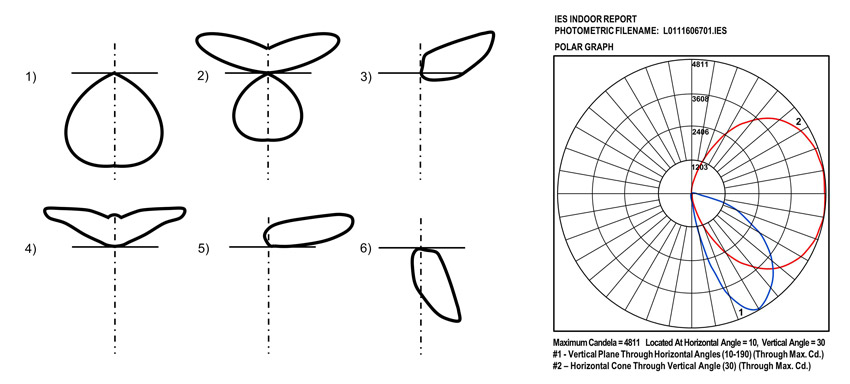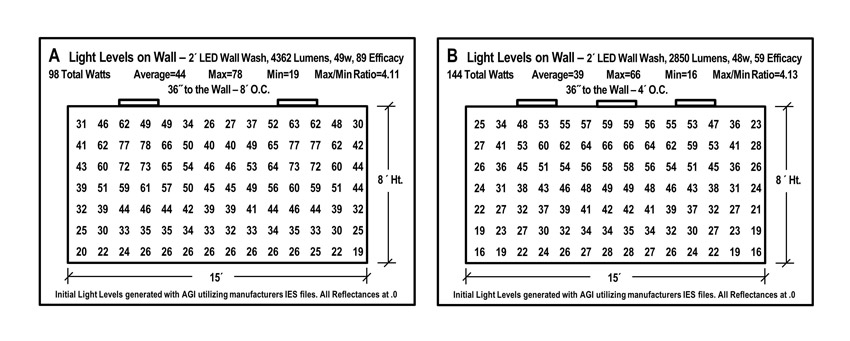The Characteristics of a High-Quality LED Luminaire
Puts the Right Amount of Light Where it is Needed
One critical aspect of designing a successful lighting environment in any type of project is identifying how much light is needed throughout the space and where, specifically, it is needed. The next step is finding a fixture that can get it there.
Identifying the Right Amount of Light
The IES has developed recommendations about the optimal amount of light that should be available for performing a variety of visual tasks and also provides recommendations that identify sufficient illumination levels for specific types of space. The Lighting Handbook, published by the IES, recommends that office buildings be designed to maintain 400 lux (40 footcandles) at the work plane in a private office and open-plan office and 300 lux (30 footcandles) at the work plane in a conference room. The work plane is identified as being 21/2 feet above finished floor (AFF), which aligns with the height of the standard desk. In circulation areas, such as stairwells and corridors, the optimal light levels must be maintained on the floor so that occupants can move safely through the space. In multifunctional spaces, such as video conference rooms, special attention must be paid to the illumination levels on all surfaces within camera shot. Faces, walls, furnishings, and even the camera itself cannot be over-illuminated or under-illuminated to protect the integrity and quality of the teleconference.
Typical Distribution Patterns
A defining feature of a quality lighting fixture is its ability to distribute light into the spaces it is wanted and keep light out of the areas it is not. The distribution pattern of a fixture illustrates how the light exits the fixture and illuminates the space.

Images courtesy of ELP Lighting
Pictured are sketches of the general distribution patterns for six popular types of commercial lighting fixtures (left). These illustrations should not be confused with a polar graph (right), which is often included as part of a luminaire’s photometric report and indicates the light distribution from the vertical and horizontal plane.
Here are the general distribution patterns for six popular types of commercial lighting fixtures. These illustrations should not be confused with a polar graph (included as part of a luminaire’s photometric report), which indicates the light distribution from the vertical plane but also the horizontal plane. These six examples only show distribution on the vertical plane as a cross-section through the luminaire. The horizontal axis indicates the plane upon which the fixture is mounted. If the light is emitted only below the horizontal axis, then the fixture is a direct fixture that illuminates a space by shining light down directly into the interior space. If light is emitted only above the horizontal axis, then the fixture is an indirect fixture that illuminates a space by reflecting light off of the ceiling. If light is emitted both above and below the horizontal line, the fixture is a direct-indirect fixture that employs both direct and indirect methodologies for illuminating a space.
The vertical axis also illustrates the directionality of the fixture’s light distribution. If light is emitted the same on both sides of the vertical axis, the fixture has a symmetric distribution. The typical downlight, for example, has a symmetric distribution. If the majority of light is emitted on only one side of the vertical axis, the fixture has an asymmetric distribution pattern, which would be typical of a wall wash or cove light fixture.
Downlight
The typical downlight emits light directly into the interior space in a 360-degree spherical pattern. It is important to be mindful of spacing when specifying fixtures with a spherical distribution pattern because if the fixtures are set too far apart, the illumination in a space can feel uneven, with the brightest areas existing directly underneath the fixture, and then dim as one approaches the perimeter of the fixture’s coverage area.
Direct-Indirect Fixture
The direct-indirect fixture emits light both directly into the space and reflects light off of the ceiling. Without the additional horizontal distribution shown in a polar graph, a specifier would not know if the fixture was linear or a single pendent-mount installation. The indirect component of the fixture emits light with a distribution that is characterized as batwing. The batwing distribution pattern provides wider and more even illumination across a ceiling surface than a spherical distribution would provide.
Indirect Wall-Mounted Fixture
The indirect wall-mounted fixture provides light into a space by reflecting the light off of the ceiling. These fixtures are wall-mounted and typically only project light asymmetrically, away from the wall they are mounted on and above the horizontal axis.
Indirect Light Fixture
An indirect light fixture that is not wall-mounted but suspended from the ceiling casts light onto the ceiling to illuminate a space indirectly. The distinct batwing distribution pattern provides wide and even illumination.
Cove Light Fixture
Cove light fixtures illuminate an interior by uplighting the ceiling and projecting the light asymmetrically away from the wall where the cove is built and above horizontal axis.
Wall Wash Fixture
A wall wash fixture provides a smooth, direct wash of illumination onto the wall. Wall wash fixtures can have a linear light source providing a smooth, direct wash of illumination onto the wall from a perpendicular plane where it is mounted, usually the ceiling. Wall wash fixtures utilizing a point source of light are often used to create visual interest or highlight important features of the space, such as room numbers or graphical treatments. Creating the illusion of a smooth, even wall wash can be achieved if the light levels on the illuminated wall are within a within a four-to-one ratio. The human eye views anything within a four-to-one ratio as evenly lit. Conversely, to specifically highlight something on the wall, the highlighted area should be five times brighter than the surrounding area so the eye will visually note it as brighter.

Images courtesy of ELP Lighting
Designs using more efficient luminaires may achieve the same light levels on the target surface with fewer fixtures, as is demonstrated in this comparison of two wall wash fixtures.
The LED Distribution Challenge
Good distribution is one area that has been a challenge in the development and broad application of relatively new LED fixtures. As a light source, LEDs are unique in that they are a point source. Each individual LED chip emits light in a unidirectional, 120-degree arc. This is very different from the 360-degree omnidirectional emission pattern of a fluorescent lamp or even an incandescent bulb. Simply placing an LED board into a fixture designed for a fluorescent or incandescent light source yields a very unsatisfactory result. Manufacturers are still learning about the best ways to manage and manipulate this light source with a reflector and/or lens so, before specifying an LED fixture, review the distribution chart to ensure that it is able to place the right amount of light in the right spaces.
The Spacing Opportunity
Advancements in the materials and design of optical systems are enabling fixtures to project light further and further, increasing the amount of space that can exist between fixtures in an area, without compromising the uniformity of the illumination. This exaggerated spacing enables designers to provide the necessary amount of light on a project with fewer fixtures, creating cost savings by reducing the number of fixtures that must be purchased and reducing the amount of time contractors must spend installing fixtures.









